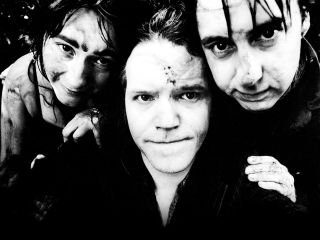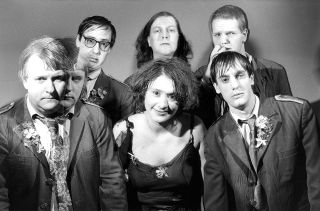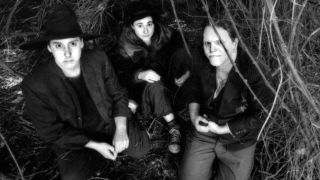In June 2008, Cardiacs frontman Tim Smith went to see My Bloody Valentine at the Roundhouse in London. A few hours later, en route to meeting some friends, he suffered a massive heart attack and stroke. A second stroke followed in hospital soon after, leaving him paralysed down one side of his body and unable to talk. Placed in a neurological rehab unit in Wiltshire, the prognosis looked grim.
Smith had been the singer, songwriter, producer and driving force of Cardiacs ever since they formed, as Cardiac Arrest, in 1977. Their unclassifiable brand of music – a delirious fever of pop, punk, prog, psychedelia and more – has made them one of our more distinctive treasures, an absurdist paradise that’s drawn famous fans from Radiohead and Steven Wilson to Andy Partridge and Knifeworld. A whole host of names turned out for 2010’s Leader Of The Starry Skies: A Tribute To Tim Smith, Songbook 1, the proceeds of which helped raise funds for his ongoing care. The man himself, meanwhile, has been absent from recording since his illness. For the longest time it seemed as though we may never hear from him again. That is, until now.
Last summer, he returned to the studio to complete an album begun in 1992 by Cardiacs offshoot The Sea Nymphs, comprising Smith, his then-wife Sarah and William D Drake. The result is finally here in the form of On The Dry Land, a glorious concoction of wonky psychedelia, ethereal folk pop and surreal wit. It’s a collaboration that carries the Cardiacs imprint, though pressed in softer tones of organ and sax, rather than buzzing guitar noise.
“It was a very emotional experience,” says Sarah Smith of her ex-husband’s re-entry to work. “It was an extraordinary thing that Tim could get back to his studio and that we could all get together. But on one level it was just exactly the same as it always was. The fact that he basically can’t speak now didn’t make it that different. Craig [Fortnam, the Cardiacs] was the interpreter and I could see from Tim’s face whether it was working or not. Tim still knows exactly what he wants. He’s a total perfectionist and we did a whole day of takes, just for a few lines that I sang for a song called After. He’s completely on the ball.”

The origins of The Sea Nymphs can be traced back to 1984, when the trio took leave of Cardiacs to make an album as Mr And Mrs Smith And Mr Drake. By the time they reconvened in 1991 for a single, Appealing To Venus, they were trading as The Sea Nymphs. A self-titled LP arrived a year later. The vast bulk of On The Dry Land was recorded around then too, but it remained unfinished due to exigent Cardiacs business. However, tantalisingly, three of its tracks were to fetch up on a John Peel session in 1998.
Granting Prog his first substantial interview since his illness, communicating via a specially adapted keyboard, Tim Smith tells us, “On The Dry Land was always on my mind. But there’s so much more Sea Nymphs stuff to be finished whenever we can find the box, or whatever it was we buried it in.”
He also points out that The Sea Nymphs was a necessary entity, something altogether separate from Cardiacs: “If you’ve got a song that goes mulling, creeping and crawling round your head, and you know the others in the band won’t understand because it’s not rock’n’roll, you have to say, ‘Hey! All this heavy shit is messing with my karma,’ and just walk out and see who follows. So Sarah and William D Drake and I ended up as we three of the sea.”
He adds: “I’m glad you picked up on the psychedelic-ness. That always makes me feel good, ’cause we never sat down and discussed our approach. The album title speaks for itself. Sea nymphs on the dry land was we.”
For Sarah, recalling the album sessions in picturesque Anglesey, North Wales, the band name was crucial. “All of us are pretty deeply rooted to the sea,” she explains. “Between the three of us, it’s probably our favourite place to be. When Tim was little, his dad used to have a boat. And I know that Bill’s dad had a boat and that Bill once lived by the sea in Ireland. And my grandparents were all fishermen, so when I was little I used to go down to the quay in North Shields.
- Kavus Torabi's Guide To Cardiacs
- The 10 best Cardiacs songs as chosen by Mike Vennart
- Mike Vennart set free to be silly
- The Sea Nymphs - On The Dry Land album review
“The nature of the sea is a bit like the music itself – quite a struggle, but also incredibly beautiful and unpredictable. And quite mysterious. I think that’s like life, isn’t it?”
William D Drake remembers the album sessions fondly. “We went up to Rhosneigr in Anglesey and recorded for three weeks,” he says. “We’d get up very late, Sarah would cook us some gulls’ eggs that she’d foraged for, and maybe some wild potatoes that she’d dug up from somewhere. Tim and I were inseparable really, writing parts and getting things down. We just didn’t stop, then we’d go for walks at night. In the evening we’d listen to what we’d done that day, have a few spliffs and just carry on till three or four in the morning. We’d probably have quite a lot of beer, go to bed, then start again the next day.
“We didn’t get bored because it was just magical. There’s still more material from those sessions – at least one more album’s worth – but we need to do some vocals on it. Now we have the momentum to finish it. On The Dry Land had me playing the television organ, which was a bit of a fiend, because we hadn’t sampled it in those days.”
The melodic flutter of the aforementioned instrument is a signature motif of On The Dry Land. “It was made by accident by Bill somehow,” asserts Tim, citing a well‑known piece of Cardiacs lore that states the television organ came into being after Drake tried to fix a dodgy TV set. “It’s a bit odd because he can’t even put a fucking household plug on.”
Aside from other defining sounds, like Sarah’s sax and clarinet, the album was also made with sundry things they happened to find. “I will tell you about the strangest thing,” says Smith. “We all went down to the seafront to make sandcastles. It got dark, so we got ourselves a wheelbarrow and filled it with wet sand. We had to make several journeys.”
The three of them then proceeded to build a seven-foot-high structure in the centre of the carpet, decorated with mussel shells, kitchen pans and stray pieces of furniture, and began dancing “and pushing each other’s hopeless bodies into it”. The result was one of their most charmingly outré songs, The Black Blooded Clam.

This sense of giddy abandon, of creativity through play, was crucial to the feel of On The Dry Land. “You make music with your heart, enjoy what you’re doing and just see what happens,” explains Drake, who had quit Cardiacs to pursue other projects in 1991. “There was nothing considered about it. It was all done for the sheer love of it. We’ve always been like that. People call me an ex-Cardiac, but you never stop being one. Once a Cardiac, always a Cardiac. That strong bond and love has always been there. And it always will be.”
It’s a sentiment echoed by Sarah who, at the time of On The Dry Land, had given up her role as a full-time Cardiac, preferring instead to appear on their albums as a guest. “It was all about being best friends and laughing a lot,” she says. “There were no barriers. I think that’s why I haven’t really done anything musical since. We were all very hard-working, but we also just mucked around. I’ve tried playing in other bands since, but it’s never actually meant anything to me.
“Life’s about feeling completely at ease with people. I’m eternally grateful [to Tim], but it’s also a curse. I can’t do it any more because it was just an extremely magical thing. The Sea Nymphs wasn’t invented to be a band in the same way as Cardiacs. It was our quieter side. We could play as many things as we wanted and overdub as much as we liked, knowing we’d never play this music live. The Sea Nymphs was always my favourite thing, so it’s pretty special for this album to finally come out.”
It’s only fitting that the last word should go to Tim, whose synopsis of those album sessions is: “Up in the morning, bed at bedtime and a whole bunch of tunes and stuff in between. This became our tunes-and‑stuff sandwich.”
Meanwhile, he hasn’t completely given up on the possibility of returning to pilot Cardiacs at some point in the future, despite everything he’s been through. “Cardiacs will always be here,” he says. “As for me, I’m still fighting them critters who are trying their best to stop me. But they are losing.”
On Dry Land is out now on Alphabet Business Concern. See www.cardiacs.net for details.
-–


